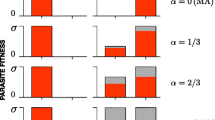Abstract
We modelled the evolution of virulence when co-infections were permitted and compared patterns generated by our modelling approach with those of other models. In support of current models, we found that strains with virulences above the maximum basic reproductive rate (Ro) were competitively superior, and that both high host density (as indexed by host encounter rate) and high parasite infectiousness favoured evolution of strains with high virulence. However, we found that co-existence typically did not continue indefinitely and that parasites with high virulences, and Ro values approaching unity, often did not persist. We examined the extent to which processes such as stochasticity and positive frequency dependence influenced patterns generated by our model. Also, we examined commonly used indices of parasite fitness [i.e. Ro and rate of spread (ROS)], and found that only ROS was positively related to competitive ability when co-infections were permitted. However, there was considerable variation in competitive ability that was not explained by variation in ROS. We conclude that our modelling approach can significantly influence patterns generated and that conclusions from single models or conclusions based on current indices of parasite fitness should be viewed with caution. We suggest empirical tests that distinguish our model from other models and further examine the impact of mechanisms such as positive frequency dependence on the evolution of virulence.
Similar content being viewed by others
References
Anderson, R.M. and May, R.M. (1982) Coevolution of hosts and parasites. Parasitology 85, 411–426.
Antia, R., Levin, B.R. and May, R.M. (1994) Within-host population dynamics and the evolution and maintenance of microparasite virulence. Am. Nat. 144, 457–472.
Bremermann, H.J. and Pickering, J. (1983) A game-theoretical model of parasite virulence. J. Theor. Biol. 100, 411–426.
Bremermann, H.J. and Thieme, H.R. (1989) A competitive-exclusion principle for pathogen virulence. J. Math. Biol. 27, 179–190.
Bull, J.J. (1994) Perspective: Virulence. Evolution 48, 1423–1437.
Dwyer, G., Levin, S.A. and Buttel, L. (1990) A simulation model of the population dynamics and evolution of myxomatosis. Ecol. Monogr. 60, 423–447.
Ebert, D. (1994) Virulence and local adaptation of a horizontally transmitted parasite. Science 265, 1084–1086.
Fenner, F. (1983) Biological control, as exemplified by small-pox eradication and myxomatosis. Proc. R. Soc. Lond. B 218, 259–285.
Fenner, F., Day, M.F. and Woodroofe, G.M. (1956) The epidemiological consequences of the mechanical transmission of myxomatosis by mosquitoes. J. Hygiene 54, 284–303.
Fenner, F., Poole, W.E., Marshall, I.D. and Dyce, A.L. (1957) Studies in the epidemiology of infectious myxomatosis. VI. The experimental introduction of the European strain of myxoma virus into Australian wild rabbit populations. J. Hygiene 55, 192–206.
Frank, S.A. (1996) Models of parasite virulence. Quart. Rev. Biol. 71, 37–78.
Grenfell, B.T. and Dobson, A.P. (1995) Ecology of Infectious Diseases in Natural Populations. Cambridge University Press, Cambridge.
Lenski, R.E. and May, R.M. (1994) The evolution of virulence in parasites and pathogens: Reconciliations between two competing hypotheses. J. Theor. Biol. 169, 253–265.
Levin, B.R. (1988) Frequency-dependent selection in bacterial populations. Phil. Trans. R. Soc. Lond. B 319, 459–472.
Levin, B.R. (1996) The evolution and maintenance of virulence in microparasites. Emerg. Infect. Dis. 2, 93–102.
Levin, B.R. and Svanborg-Edén, C. (1990) Selection and evolution of virulence in bacteria: An ecumenical excursion and modest suggestion. Parasitology 100, S103-S115.
Levin, S.A., Grenfell, B.T., Hastings, A. and Perelson, A.S. (1997) Mathematical and computational chal-lenges in population biology and ecosystems science. Science 275, 334–343.
Massad, E. (1987) Transmission rates and the evolution of pathogenicity. Evolution 41, 1127–1130.
May, R.M. and Anderson, R.M. (1983) Epidemiology and genetics in the coevolution of parasites and hosts. Proc. R. Soc. Lond. B 219, 281–313.
May, R.M. and Nowak, M.A. (1995) Coinfections and the evolution of parasite virulence. Proc. R. Soc. Lond. B 261, 209–215.
Mead-Briggs, A.R. and Vaughan, J.A. (1975) The differential transmissibility of myxoma virus strains of di.ering virulence grades by the rabbit flea Spilopsyllus cuniculi (Dale). J. Hygiene 75, 237–247.
Nowak, M.A. and May, R.M. (1994) Superinfection and the evolution of parasite virulence. Proc. R. Soc. Lond. B 255, 81–89.
Parer, I., Conolly, D. and Sobey, W.R. (1985) Myxomatosis: The effects of annual introductions of an immunizing strain and a highly virulent strain of Myxoma virus into rabbit populations at Urana, N.S.W. Aust. Wildl. Res. 12, 407–423.
Ross, J. (1982) Myxomatosis: The natural evolution of the disease. Symp. Zool. Soc. Lond. 50, 77–95.
Schall, J. (1990) Virulence of lizard malaria: The evolutionary ecology of an ancient parasite-host association. Parasitology 100, s35–s52.
Van Balaan, M. and Sabelis, M.W. (1995) The dynamics of multiple infection and the evolution of virulence. Am. Nat. 146, 881–910.
Author information
Authors and Affiliations
Rights and permissions
About this article
Cite this article
Leung, B., Forbes, M.R. The evolution of virulence: A stochastic simulation model examining parasitism at individual and population levels. Evolutionary Ecology 12, 165–177 (1998). https://doi.org/10.1023/A:1006579512133
Issue Date:
DOI: https://doi.org/10.1023/A:1006579512133




